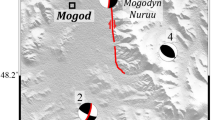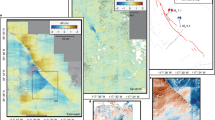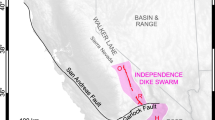Abstract
The 25-km-long section of the San Andreas fault near Parkfield, California ruptured in similar magnitude-6 earthquakes in 1881, 1901, 1922, 1934 and 1966. On the basis of a number of lines of seismological evidence, a section of the San Andreas fault, now termed the Parkfield preparation zone, has been identified as the locus of the next Parkfield earthquake1,3. Here we describe coincident changes in surface creep rates and deep seismicity near the Parkfield preparation zone following the 2 May 1983 Coalinga earthquake, and suggest that both respond to the same stimuli. These changes were concentrated near the point of initiation of the magnitude-6 characteristic Parkfield earthquakes, lending credence to the hypothesis that this section of the San Andreas fault is characterized by a unique set of physical properties4–6 which make it ideal for earthquake prediction studies and which may also be useful for identifying hypocentral regions in other areas.
This is a preview of subscription content, access via your institution
Access options
Subscribe to this journal
Receive 51 print issues and online access
$199.00 per year
only $3.90 per issue
Buy this article
- Purchase on Springer Link
- Instant access to full article PDF
Prices may be subject to local taxes which are calculated during checkout
Similar content being viewed by others
References
1. Bakun, W. H. & McEvilly, T. V. /. geophys. Res. 89, 3051–3058 (1984). 2. Bakun, W. H. & Lindh, A. G. Earthquake Pred. Res. 3, 285–304 (1985). 3. Shearer, C. F. U.S. geol. Surv. Open–File Report 85–201 (1985). 4. Schulz, S. S., Mavko, G. M. & Brown, B. D. Prof. Pap. U.S. geol. Surv. (in the press). 5. King, G. Pure appl. Geophys. 121, 761–815 (1983). 6. Lindh, A. G. & Boore, D. M. Bull seism. Sac. Am. 71, 95–116 (1981). 7. Schulz, S. S., Mavko, G. M., Burford, R. O. & Stuart, W. D. /. geophys. Res. 87, B6977–B6982 (1982). 8. Eaton, J. P., O'Neill, M. E. & Murdock, J. N. Bull, seism. Soc. Am. 60, 1151–1197 (1970). 9. Bakun, W. H. & Lindh, A. G. Science 229, 619–624 (1985). 10. Moths, B. L., Lindh, A. G., Ellsworth, W. L. & Fluty, L. Eos 62, 958 (1981). 11. Olson, J. A. Bull. R. Soc. N.Z. 24, 87–97 (1986). 12. Bolt, B. A. Bull, seism. Soc. Am. 50, 457–471 (1968). 13. Lindh, A. G. & Jones, L. Eos 66, 982 (1985). 14. Poley, C. M., Lindh, A. G. & Bakun, W. H. Earthquake Not. 57, 21 (1986). 15. O'Neill, M. E. Bull seism. Soc. Am. 74, 27–40 (1984). 16. Schulz, S. S. & Burford, R. O. Eos 66, 985 (1985). 17. Mavko, G., Schulz, S. S. & Brown, B. D. Bull, seism. Soc. Am. 75, 475–489 (1985). 18. Stuart, W. p., Archuleta, R. J. & Lindh, A. G. /. geophys. Res. 90, 595–604 (1985). 19. Tse, S. T., Dmowska, R. & Rice, J. R. Bull, seism. Soc. Am. 75, 709–736 (1985).
Author information
Authors and Affiliations
Rights and permissions
About this article
Cite this article
Poley, C., Lindh, A., Bakun, W. et al. Temporal changes in microseismicity and creep near Parkfield, California. Nature 327, 134–137 (1987). https://doi.org/10.1038/327134a0
Received:
Accepted:
Issue Date:
DOI: https://doi.org/10.1038/327134a0
This article is cited by
-
Fluid-mediated influence of adjacent thrusting on the seismic cycle at Parkfield
Nature (1996)
-
Retardations in fault creep rates before local moderate earthquakes along the San Andreas fault system, central California
Pure and Applied Geophysics PAGEOPH (1988)
-
Rock friction constitutive behavior from laboratory experiments and its implications for an earthquake prediction field monitoring program
Pure and Applied Geophysics PAGEOPH (1988)
-
The response of creeping parts of the San Andreas fault to earthquakes on nearby faults: Two examples
Pure and Applied Geophysics PAGEOPH (1988)
Comments
By submitting a comment you agree to abide by our Terms and Community Guidelines. If you find something abusive or that does not comply with our terms or guidelines please flag it as inappropriate.



